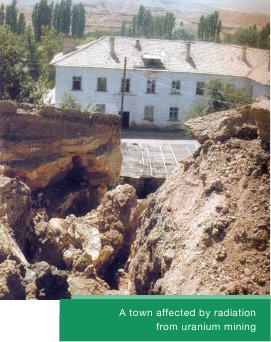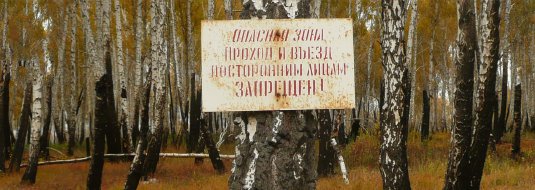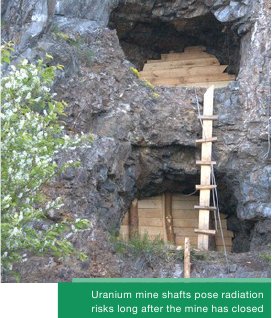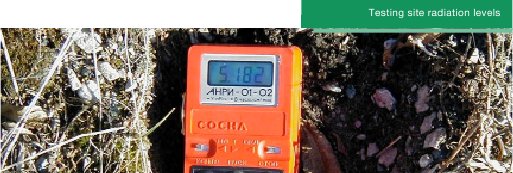Radionuclides
Estimated Population At Risk At Identified Sites:
3.3 Million People
Estimated Global Impact:
5 to 8 Million People
Introduction
 Radionuclides occur naturally in soil and rocks as a consequence of radioactive decay. A radionuclide is described as an atom with an unstable nucleus. Radioactivity is produced when this unstable nucleus, which is characterized by excess energy, either forms this energy into radiation particles within the nucleus or into an atomic electron. When materials decay, they emit radiation and eventually disintegrate over time. Radioactive materials reduce this activity within their “half-life,” which is defined as the time required for reducing the activity of a radioactive substance to half of its initial value. Radioactive half-lives span from fractions of a second to millions of years. Those materials that emit radiation over long periods have the most adverse effects on human health. The main categories of harmful radioactive materials emitted during radiation are identified as Alpha, Beta, Gamma, and Neutron radiation. [97] Radioactive materials cannot be treated, and only lose their harmful effect when they have finished decaying. Because this can take millennia, these materials must be stored appropriately.
Radionuclides occur naturally in soil and rocks as a consequence of radioactive decay. A radionuclide is described as an atom with an unstable nucleus. Radioactivity is produced when this unstable nucleus, which is characterized by excess energy, either forms this energy into radiation particles within the nucleus or into an atomic electron. When materials decay, they emit radiation and eventually disintegrate over time. Radioactive materials reduce this activity within their “half-life,” which is defined as the time required for reducing the activity of a radioactive substance to half of its initial value. Radioactive half-lives span from fractions of a second to millions of years. Those materials that emit radiation over long periods have the most adverse effects on human health. The main categories of harmful radioactive materials emitted during radiation are identified as Alpha, Beta, Gamma, and Neutron radiation. [97] Radioactive materials cannot be treated, and only lose their harmful effect when they have finished decaying. Because this can take millennia, these materials must be stored appropriately.
While radionuclides occur naturally in the environment, those categorized as harmful are typically of anthropogenic origin, released through industrial processes. Hundreds of radionuclides exist, and the Nuclear Regulatory Commission separates radioactive materials into high-level or low-level classes. [98] High-level radioactive material primarily results from the fuel used by a reactor to produce electricity, while low-level wastes includes material that either has a short decay period or has become contaminated with or activated by nuclear materials. These materials can include clothing used in the nuclear industry, medical materials, or radiation sources from inside of reactors. Similarly, the US Environmental Protection Agency has classified radionuclides into “heavy” or “light” nuclides: heavy refers to elements that have over 83 protons, and are thus also categorized as unstable, while light refers to elements that have fewer than 83 protons. [99]
Uranium mining and the use of nuclear reactors are common sources of radionuclides, which are primarily contained within radioactive wastes. Typical radionuclides produced through nuclear reactors via the splitting of elemental atoms are thallium-201 and iridium-192. The processing of uranium in such reactors likewise produces isotopes such as cesium-137 and strontium-90, which take a significantly long time to decay. Additionally, uranium-238 decays to form radium-226, which has a half-life of 1600 years. [100] Because many of these radioisotopes remain active in industry by-products and wastes for such long periods of time, they are also known as transuranic wastes. [101] Other commonly encountered radionuclides include cobalt-60, plutonium, radium, radon, technetium-99, thorium, and uranium. [102]
Radionuclides are used for a variety of purposes, many of which can be highly beneficial. Radionuclides are useful both for their chemical properties and as sources of radiation. For example, radioisotopes are used in biomedicine in the diagnosis, treatment, and research into disease. Radioactive elements that emit gamma rays can be used as tracers to monitor bodily states and the functioning of organs, while others, such as radium and radon, can be used in the treatment of certain cancerous tumors. [103] Additionally, in scientific research into genetics, radionuclides allow scientists to label molecules and study processes such as DNA replication. Another primary usage of radionuclides, specifically the element uranium, is for energy production.

Common Exposure Pathways and Health Risks
Radionuclides can be released into the environment through accidents, poor waste disposal, or other means. Some levels of radiation are naturally present in surface and ground water, but other degrees of radiation exposure come from contact with rocks and soil that have been contaminated with the artificially produced radionuclides mentioned above, such as radon. Often, contaminated soil and rock are the by-products of wastes and tailings from mineral extraction sites, where ores such as uranium are taken for their radioactive properties and industrial uses.
Once elements such as uranium have been processed in sites such as nuclear reactors, radiation exposure can also occur through leaks and industrial failures. Exposure to radiation can also occur when radionuclides are used in excess during medical treatments. These levels of exposure and the effects they produce are called radiation poisoning. Some major pathways to commonly encountered hazardous radionuclides are through inhalation (uranium and radon), food contamination (radium), and occupational exposure at mining and processing sites. [104]
Acute health effects due to a large radiation exposure begin with nausea, vomiting, and headaches. With increased exposure a person may also experience fatigue, weakness, fever, hair loss, dizziness disorientation, diarrhea, blood in stool,low blood pressure, and ultimately death. Chronic and long-term effects may also occur.
Uranium is known as a radioactive toxicant capable of damaging the kidneys and genetic code, which can result in health problems passed to the following generations. Radon is a human lung carcinogen and particularly damaging to miners who extract ores containing radioactive elements. Radon is also the second leading cause of lung cancer death in uranium miners. [105] [106] Studies also show that long-term exposure to radon leads to an elevated risk of leukemia. [107] Chronic exposure to radium through the inhalation pathway can lead to leukopenia, a decrease in the number of white blood cells, which places an exposed individual at an increased risk for contracting infections. [108]
When ionizing radiation strikes an organism’s cells, it may injure the cells. If radiation affects a significant number of cells, it can eventually lead to cancer. At extremely high doses, this type of exposure can cause dealth. In general, there is no safe level of radiation exposure. Individuals exposed to non-lethal doses may experience changes in blood chemistry, as well as nausea and fatigue. Children are particularly vulnerable, as radiation has an effect on the cellular level. As children grow, they divide more and more cells, and more opportunities exist for radiation to interfere with the development process—in terms of fetal development, this can result in smaller head or brain size, poorly formed eyes, abnormal growth, and mental retardation. [109]

Industrial Sources of Pesticides – Uranium Mining and Radioactive Waste Disposal
Industry Overview
Uranium mining is the process of extracting uranium ore from the ground. Most mining of uranium is volume-intensive and takes place as open-pit mining, primarily due to the typically low concentrations of the element. The actual uranium content of the ore can be as low as 0.1% to 0.2%; therefore, large amounts of ore must be mined to extract any significant quantity of the material. [110]
 Two of the primary means to extract this volume of uranium are open-pit mining and in-situ leaching. In open pit mining, ore is removed through drilling and blasting methods. Meanwhile, water is used to limit the levels of airborne dust particulates. With in-situ leaching—also known as solution mining—a leaching liquid is injected via wells into an ore deposit. The resulting liquid, which contains significant traces of uranium, is then pumped to the surface. Because of its low production costs and decreased disturbance of the extraction surface, the latter method is used more and more extensively.
Two of the primary means to extract this volume of uranium are open-pit mining and in-situ leaching. In open pit mining, ore is removed through drilling and blasting methods. Meanwhile, water is used to limit the levels of airborne dust particulates. With in-situ leaching—also known as solution mining—a leaching liquid is injected via wells into an ore deposit. The resulting liquid, which contains significant traces of uranium, is then pumped to the surface. Because of its low production costs and decreased disturbance of the extraction surface, the latter method is used more and more extensively.
However, open-pit mining is still a widely used means to extract uranium ore. The resulting ores are crushed and leached in a uranium mill, where chemical agents such as sulfuric acid or alkaline solution are used to remove the elemental uranium. Because other metals are present in the ore—such as iron, arsenic, and lead—the uranium is further separated from the resulting leaching solution. The final raw product from this extraction process, the pure uranium, is known as “yellow cake,” and is typically sold as U308. One of the most common uses of the resulting uranium radionuclides is as fuel for nuclear power plants.
One of the main by-products of these nuclear reactors is radioactive waste; however, radioactive materials also result from other fuel processing plants, power generation facilities, military exploits, and hospitals and medical research facilities. Today, 76% of the world’s demand for uranium is for power generation, and demand for uranium is increasing globally. [111] However, due to limitations inherent in the uranium extraction process, mining is undertaken in only a small number of countries; because uranium concentrations in ore can be as low at 0.1% to 0.2%, concentrations must be high enough to counter the financial costs of extraction. According to the World Nuclear Association, roughly 63% of global uranium production from mines comes from Kazakhstan, Canada, and Australia. Additionally, Kazakhstan accounts for 27% of the global uranium supply from mines.
Following the above three nations, other key uranium producing countries include Namibia, Russia, Niger, and Uzbekistan. In line with and adding to these statistics, Blacksmith Institute has identified Ukraine, Kazakhstan, Tajikistan, Kyrgyzstan, Russia, Uzbekistan, China, and India as some of the countries most impacted by uranium mining and radioactive wastes. Likewise, many of the above countries that fall under the classification of low- to middle-income nations practice uranium mining and processing without strict industrial safety standards
Because most uranium ores only contain roughly 0.1% to 0.2% uranium, 99.9% of the ore remains. Between both the other elements and metals in the ore and the chemical agents used in the milling stage, the remaining sludge is highly toxic, often containing heavy metals and contaminants such as arsenic and various chemicals. As long-lived radionuclides such as thorium-230 and radium-226 are not removed, this sludge can also contain 85% of the initial radioactivity of the ore. [112] Additionally, the waste rock produced during open pit mining is discarded as waste piles, and thus often contains elevated concentrations of radioisotopes. The by-product of extraction and milling can be a toxic and radioactive tailings sludge.
Exposure Pathways from Uranium Mining and Waste Disposal
Unless properly managed for long-term stability and security, mining wastes and milling tailings from radioactive ores present serious threats to human health. through their potential to leak these radioactive materials. Unfortunately, uranium mining in low- and middle-income countries is often not regulated with the type of oversight available in high-income countries, and production rather than safety is often the priority. In some instances, tailings have even been used in home construction.
Although tailings often have only low-grade radioactivity, they can be dangerous because of the large quantities that are stockpiled in small areas. Additionally, water that is pumped away from the mine during operations can contaminate local surface waters. Proximity to radioactive materials—both waste dumps and infrastructure built from mining wastes—can result in exposure to Gamma particles and Neutron radiation.
Contamination of food and water sources can occur from dust transported by wind from uranium mine sites and waste deposits. One study in Kazakhstan demonstrated that wind had transported dust particles contaminated with uranium and thorium from a uranium-mining site to plants outside the city of Aktau. [113] Other studies have shown how—because of the long half-lives of many of these radioactive materials—even legacy uranium mines can lead to exposure through food crops and contaminated agricultural soils. [114]
What is Being Done
Some countries have well-regulated industries and manage radioactive waste appropriately. In particular, there are government regulations in place, both nationally and internationally, for managing high-level radioactive wastes. However, in many countries, typically low- and middle-income nations, inforcement of legislation is lax and there is insufficient industry or government effort to properly address the issues that arise from radioactive waste. Blacksmith Institute is identifying local partners and locations where possible remediation projects can be implemented to address some of the highest priority challenges.

The approaches to dealing with uranium mining wastes are similar to those required to contain and stabilize any mining waste, with the additional need to reduce or eliminate critical pathways such as use of contaminated water sources or food production on radiation-polluted soils. Given the poor and remote areas where uranium mining is often located, the options for impacted populations may be very limited. Blacksmith Institute has been successful in Krasnoufimsk, Russia, where over 80,000 tons of radioactive materials—including thorium and uranium—had been stored for decades, leading to a high incidence of cancer. Working with the local government and a partner NGO, Blacksmith was able to construct safer and more secure warehouses for the waste, as well as raise local awareness about the scope of the problem.
Blacksmith Institute has also had success in the village of Romanovka, Russia, where abandoned ditches from a nearby uranium mine have been exposed to open air, exposing residents to radioactive substances in air and water, which possibly have lead to a cancer cluster in this community. Through local partnerships with the Baikal Center for Public Environmental Expertise, Blacksmith has recently worked to cover the ditches with fresh and safe soil. The Center also conducted a teaching workshop to educate community members of the potential risks, raise public awareness of mining impacts, and recommend personal steps to avoid future exposure.
Footnotes
[97] United States Nuclear Regulatory Commission. “Backgrounder on Radioactive Waste.” Available at http://www.nrc.gov/reading-rm/doc-collections/fact-sheets/, April 12, 2007.
[98] Ibid.
[99] U.S. Environmental Protection Agency. “Commonly Encountered Radionuclides.” Available at http://www.epa.gov/rpdweb00/radionuclides/index.html, October 1, 2010.
[100] Agency for Toxic Substances and Disease Registry. “Case Studies in Environmental Medicine. Radon Toxicity.” Public Health Service, U.S. Department of Health and Human Services, 1992.
[101] United States Nuclear Regulatory Commission. “Backgrounder on Radioactive Waste.” Available at http://www.nrc.gov/reading-rm/doc-collections/fact-sheets/, April 12, 2007.
[102] U.S. Environmental Protection Agency. “Commonly Encountered Radionuclides.” Available at http://www.epa.gov/rpdweb00/radionuclides/index.html, October 1, 2010.
[103] U.S. Environmental Protection Agency. “Radionuclides (Including Radon, Radium and Uranium).” Available at http://www.epa.gov/ttn/atw/hlthef/radionuc.html, November 6, 2007.
[104] Ibid.
[105] M. Al-Zoughool and D. Krewski. “Health Effects of Radon: A Review of the Literature.” International Journal of Radiation Biology 85.1 (2009): 57–69.
[106] B. Vacquier, et al. “Mortality Risk in the French Cohort of Uranium Miners: Extended Follow-up 1946–1999.” Occupational and Environmental Medicine 65.9 (2008): 597–604.
[107] M. Möhner, et al. “Leukemia and Exposure to Ionizing Radiation among German Uranium Miners.” American Journal of Industrial Medicine 49.4 (2006): 238–248.
[108] Occupational Safety and Health Administration. “Occupational Safety and Health Standards, Toxic and Hazardous Substances.” Code of Federal Regulations. 29 CFR 1910.1000, 1998.
[109] Radiation Protection: Health Effects.” U.S. Environmental Protection Agency. Available at http://www.epa.gov/rpdweb00/understand/health_effects.html, August 28, 2008.
[110] P. Diehl. “Uranium Mining and Milling Wastes: An Introduction.” WISE Uranium Project. Available at http://www.wise-uranium.org/uwai.html, August 15, 2004.
[111] World Nuclear Association. “World Uranium Mining.” Available at http://www.world-nuclear.org/info/inf23.html, May 2010.
[112] P. Diehl. “Uranium Mining and Milling Wastes: An Introduction.” WISE Uranium Project. Available at http://www.wise-uranium.org/uwai.html, August 15, 2004.
[113] R. Lennartz and M. Zoriy. “Biomonitoring of Environmental Pollution by Thorium and Uranium in Selected Regions of the Republic of Kazakhstan.” Journal of Environmental Radioactivity 101.5, (2010): 414–420.
[114] O. Neves, M.M. Abreu, and E.M. Vicente. “Uptake of Uranium by Lettuce (Lactuca sativa L.) in Natural Uranium Contaminated Soils in Order to Assess Chemical Risk for Consumers.” Water, Air, & Soil Pollution 195.1-4, (2008): 73–84.




